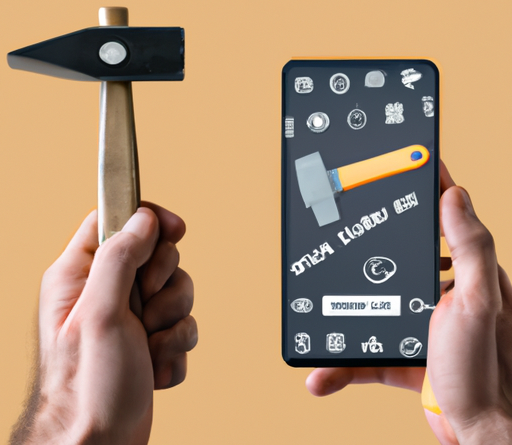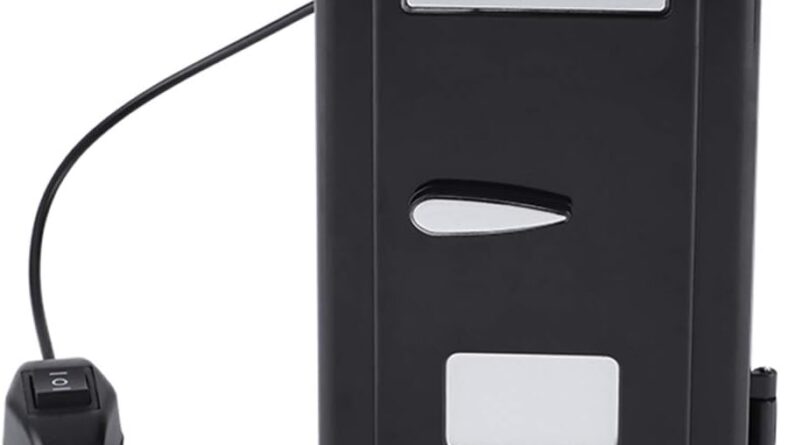
In today’s digital era, the reliability of smartphone apps versus physical tools has become a topic of debate among professionals and enthusiasts alike. With the convenience and accessibility that smartphone apps offer, it is tempting to rely solely on them for our daily tasks. However, in this article, we will explore the pros and cons of both options to help you make an informed decision on whether you should trust smartphone apps or maintain physical tools in your kit. Whether you’re a craftsman, a photographer, or simply an individual looking for reliable tools, this exploration will shed light on the reliability of these two approaches, ensuring that you are equipped with the best tools for the job at hand.”
Exploring the Reliability of Smartphone Apps versus Physical Tools in Your Kit
Introduction to the Topic
In today’s digital age, smartphones have become an integral part of our daily lives, offering a wide range of functionalities through mobile applications, or apps. These apps have made our lives more convenient, allowing us to perform various tasks with just a few taps on the screen. However, when it comes to reliability, many of us still question whether smartphone apps can truly replace physical tools in our kits. In this article, we will explore the advantages and disadvantages of both smartphone apps and physical tools, helping you make an informed decision based on your specific needs and preferences.
Advantages of Smartphone Apps
1. Convenience
One of the most significant advantages of smartphone apps is their convenience. With just a smartphone in your pocket, you have access to a multitude of tools, eliminating the need for carrying around a collection of physical tools. Whether you need a calculator, a flashlight, or even a spirit level, smartphone apps can provide these functionalities at your fingertips.
2. Wide Range of Tools
Smartphone apps offer an extensive range of tools covering various areas of interest. From productivity and organization apps to health and fitness trackers, there is a vast selection of apps available for every task imaginable. This wide range of tools allows you to customize your smartphone with apps that align with your specific needs and interests.
3. Accessibility
With the widespread availability of smartphones, apps have become easily accessible to the majority of the global population. Whether you are in a remote location or traveling abroad, as long as you have an internet connection, you can download and utilize the needed apps. This accessibility ensures that you have the necessary tools within reach, regardless of your physical location.
4. Cost-effective
Compared to purchasing physical tools individually, downloading smartphone apps is often more cost-effective. Many apps are available for free or at a significantly lower cost than their physical counterparts. This affordability allows users to access a wide range of tools without breaking the bank, making it a cost-effective option for those on a budget.
5. Real-time Updates
Smartphone apps offer the advantage of real-time updates, which can be crucial in various scenarios. For instance, weather forecasting apps can provide up-to-date information on changing weather conditions, enabling you to plan your activities accordingly. Similarly, apps for traffic updates and navigation can help you avoid congestion and find the most efficient routes in real-time.
Disadvantages of Smartphone Apps
1. Reliability Concerns
While smartphone apps have improved significantly over the years, reliability remains a concern for some users. Apps can occasionally crash, freeze, or provide inaccurate information, which can be frustrating, especially when relying on them for important tasks. It is essential to choose reputable and well-reviewed apps to minimize the risk of reliability issues.
2. Battery Life
One of the common drawbacks of using smartphone apps is their impact on battery life. Many apps consume a significant amount of power, requiring regular charging throughout the day. This reliance on battery can be problematic, particularly in situations where a power source is not readily available, such as during outdoor activities or emergencies.
3. Signal and Connectivity Issues
Smartphone apps heavily rely on a stable internet connection or cellular network signal to function correctly. In areas with weak or limited network coverage, such as remote locations or during natural disasters, the performance of these apps may be compromised or rendered unusable. In such cases, physical tools that do not rely on connectivity can provide a more reliable solution.
4. Lack of Physical Interaction
Physical tools offer a tangible and tactile experience, allowing users to feel and interact directly with the tools. Smartphone apps, on the other hand, lack this physical interaction, which can be a disadvantage for tasks that require precise measurements or fine motor skills. In these situations, physical tools may offer a more accurate and intuitive experience.
5. Dependence on Technology
Using smartphone apps means being dependent on technology, which can be a double-edged sword. While technology has significantly enhanced our capabilities, it is important to acknowledge its limitations and vulnerabilities. System failures, software glitches, or even loss or theft of the smartphone can leave you without access to critical tools when you need them the most.
Advantages of Physical Tools
1. Tangible and Tactile Experience
Physical tools provide a hands-on, tangible experience that cannot be replicated by smartphone apps. Whether it’s the feeling of a well-balanced hammer or the precision of a traditional compass, physical tools offer a level of satisfaction and control that some individuals find more fulfilling than the virtual experience provided by smartphone apps.
2. Durability and Longevity
Physical tools are often built to withstand harsh conditions and heavy usage, making them durable and long-lasting. Unlike smartphones, which can be fragile and susceptible to damage, physical tools can be relied upon for extended periods without the need for frequent replacements or repairs.
3. Independent of Technology
Physical tools do not rely on technology or internet connectivity to function, making them suitable for use in remote areas or during power outages. Tasks that require consistent and reliable performance, such as navigating in the wilderness or repairing machinery, can benefit from the independence of physical tools from technological dependencies.
4. High Accuracy
For tasks that demand precise measurements or intricate details, physical tools often offer higher accuracy compared to smartphone apps. Measuring tapes, rulers, and levels provide a level of precision that is challenging to match digitally. Professionals in fields such as construction, engineering, or woodworking often prefer physical tools due to their exceptional accuracy.
5. Trust and Familiarity
Physical tools have been used by humans for centuries, and their familiarity breeds trust. Many individuals have grown accustomed to using physical tools and have developed a level of proficiency and trust in their reliability. This trust in the familiar can provide peace of mind and confidence in the tools’ capabilities.
Disadvantages of Physical Tools
1. Limited Functionality
Physical tools are designed for specific purposes and may have limited functionality outside their intended use. In contrast, smartphone apps can provide a wide range of functionalities within a single device, reducing the need to carry multiple tools. This limitation in functionality can be a drawback for individuals who prefer versatility and multi-purpose tools.
2. Bulky and Heavy
Compared to the slim and lightweight nature of smartphones, physical tools can be bulky and heavy to carry around. Carrying a toolbox or a bag filled with tools can be cumbersome, especially when mobility and portability are essential. This bulkiness can be a disadvantage for individuals who require tools on the go or have limited storage space.
3. Expensive
Building a collection of physical tools can be expensive, especially for high-quality tools or specialized equipment. Purchasing individual tools or investing in comprehensive toolkits can quickly add up, making it financially burdensome for those on a tight budget. In contrast, smartphone apps are often more affordable or even free, minimizing the initial investment required.
4. Lack of Real-time Updates
Unlike smartphone apps, physical tools do not provide real-time updates or dynamic information. For instance, a physical map cannot adjust to changing traffic conditions, while a weather vane will not provide hourly weather forecasts. If up-to-date information is critical for your tasks, physical tools may not be the best choice.
5. Maintenance and Upkeep
Physical tools require regular maintenance and upkeep to ensure optimal performance. They may need sharpening, cleaning, or occasional repairs, which can be time-consuming and inconvenient. Failure to maintain physical tools properly can lead to decreased accuracy or even accidents, emphasizing the importance of regular maintenance.
Factors to Consider When Choosing Between Smartphone Apps and Physical Tools
When deciding between smartphone apps and physical tools, several factors should be taken into consideration based on your unique needs and preferences.
1. Purpose and Specific Requirements
Consider the specific tasks you need to perform and identify the tools or apps that best meet those requirements. Determine the functionalities and features you prioritize to make an informed decision.
2. Reliability and Accuracy Needs
Evaluate the level of reliability and accuracy you expect from the tools or apps. Assess the potential risks and consequences of any inaccuracies or malfunctions, and choose accordingly.
3. Portability and Ease of Use
Determine the level of portability and ease of use that suits your lifestyle. If you are frequently on the go or have limited storage space, smartphone apps may provide a more convenient option.
4. Cost-effectiveness
Consider your budget and the long-term costs associated with both options. Evaluate the initial investment, ongoing expenses, and potential savings offered by each choice.
5. Personal Preference
Ultimately, personal preference plays a significant role in the decision-making process. Consider your comfort level, familiarity, and overall satisfaction when using either smartphone apps or physical tools.
Examples of Reliable Smartphone Apps for Specific Tasks
1. Weather Forecasting
AccuWeather, The Weather Channel, and Dark Sky are among the many popular weather forecasting apps that provide accurate and real-time weather information, ensuring you stay informed and prepared for changing conditions.
2. Navigation and Mapping
Apps like Google Maps, Waze, and Apple Maps have become go-to tools for navigation and mapping, offering real-time traffic updates, turn-by-turn directions, and alternative routes.
3. Language Translation
Google Translate and Microsoft Translator are reliable apps that can assist you in translating languages on the go, making travel and communication in foreign countries more accessible.
4. Task Management
Apps such as Trello, Todoist, and Asana can help you organize and manage your tasks effectively, allowing you to create to-do lists, set reminders, and collaborate with others seamlessly.
5. Health and Fitness Tracking
Popular health and fitness apps like MyFitnessPal, Strava, and Fitbit enable you to track your daily activities, monitor your sleep patterns, and maintain a healthy lifestyle conveniently.
Examples of Essential Physical Tools for Various Activities
1. Outdoor Adventures
A multi-tool, a compass, and a headlamp are essential physical tools for outdoor enthusiasts, providing versatility, navigation assistance, and hands-free illumination.
2. DIY Home Improvements
For DIY home improvement projects, basic physical tools like a hammer, screwdriver set, and tape measure are indispensable for tasks ranging from hanging artwork to assembling furniture.
3. Photography and Videography
Photography and videography enthusiasts rely on physical tools such as a tripod, lens filters, and external flashes to achieve stability, creative effects, and improved lighting in their visual compositions.
4. Gardening and Landscaping
In gardening and landscaping, physical tools like pruners, shovels, and rakes are essential for maintaining healthy plants, shaping landscapes, and tending to outdoor spaces.
5. Auto Repair and Maintenance
For auto repair and maintenance tasks, physical tools such as a socket set, wrenches, and a jack are necessary for routine maintenance and occasional repairs to keep your vehicle in excellent condition.
Conclusion
The debate between relying on smartphone apps or physical tools ultimately boils down to a combination of personal preference, specific needs, and the advantages and disadvantages of each option. Smartphone apps offer convenience, wide-ranging tools, accessibility, real-time updates, and cost-effectiveness. However, concerns regarding reliability, battery life, connectivity, lack of physical interaction, and technology dependence remain.
On the other hand, physical tools provide a tangible and tactile experience, durability, independence from technology, high accuracy, and a sense of trust and familiarity. However, limitations in functionality, bulkiness, expense, lack of real-time updates, and maintenance requirements are considerations when opting for physical tools.
Ultimately, finding the right balance between smartphone apps and physical tools based on your individual needs and preferences is the key. Reflecting on the purpose, reliability, portability, cost-effectiveness, and personal satisfaction will guide you towards making an informed decision that optimizes your productivity and enhances your overall experience.






